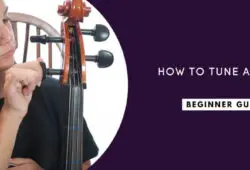Trying to choose the best cello bow for you can feel overwhelming.
While one bow may offer you better comfort and playability, another one might offer a more complex tone, making your cello sing in a way you’ve never experienced before.
The big challenge is finding the right bow that offers the perfect combination of sound, comfort, and agility at a price that fits your budget. It seems too good to be true, but the perfect bow for you does exist.
The first step is understanding your bowing needs based on your skill level and playing style. This will help you identify the features to look for in the right cello bow.
Let’s dive right in.
Table of Contents
Quick Summary
- Overall, the best cello bow we recommend is the CodaBow Diamond NX carbon fiber bow.
- If you are looking for a reasonably priced professional-quality cello bow, we recommend the JonPaul Avanti Model cello bow.
- An excellent-quality student cello bow that we recommend is the D Z Strad Model 305 Brazilwood cello bow.
- If you are looking for a budget-friendly option, the best bow under $100 that we recommend is the Viotti Carbon Fiber Cello Bow.
The Best Cello Bows To Buy In 2022
1. CodaBow Diamond NX Review
The CodaBow Diamond NX carbon fiber bow perfectly suits intermediate and advanced players.
To begin with, this handcrafted bow is constructed using high-wear components, therefore, guaranteeing that you will be using it for many years to come.
This 4/4 size bow weighs about 80g, and this nice heft allows it to grab the strings properly for better command and ease of control while playing.
Not only does this bow feel perfect in your hands, but it plays pretty great, delivering a sweet, rich tone.
Overall, the Diamond NX is an excellent quality bow in all aspects. Then again, we wouldn’t expect anything less from the brand that first developed carbon fiber bows, now would we?
- Excellent tone quality.
- Very responsive and well-balanced.
- Fluid maneuverability.
- 10-year warranty.
- It can feel heavy for some players.
2. JonPaul Avanti Model Review
Far superior to the JonPaul Bravo model carbon fiber bow, the JonPaul Avanti is an elegant cello bow that guarantees excellent value for money.
Considering what you are getting from this bow, it is actually a bargain.
Boasting outstanding workmanship, this cello bow features single-piece carbon fiber construction, which guarantees an ultra-strong bow that will hold up well to abuse.
The bow weighs 80g and is very well balanced such that it feels pleasantly lightweight in the player’s hands.
This allows for impressive agility and maneuverability, such that it articulates beautifully on the strings for rapid play response.
- Excellent value for money.
- Impressive workmanship and build quality.
- Very well balanced.
- Great feel and comfortable playing.
- None.
3. D Z Strad Model 305 Review
This 4/4 size D Z Strad cello bow is actually a favorite among Suzuki teachers and other private cello tutors.
Crafted from Brazilwood, this well-constructed bow comes with genuine, unbleached Mongolian horsehair.
The high-quality hair grips the strings beautifully for effortless playing.
At the same time, the medium stiffness of the bow enhances playability even further, giving fast response and allowing you to get a powerful tone from your instrument.
The stick weighs 78g, but it has excellent balance, so it feels very light for unrivaled maneuverability while playing.
- Aesthetically appealing.
- Excellent balance.
- Lightweight feel.
- Produces a rich, powerful tone.
- None.
4. Viotti Carbon Fiber Cello Bow Review
For its price point. You will be surprisingly impressed by the excellent quality of this Viotti bow.
To begin with, it has been constructed using the highest quality cello bow materials.
From the high-quality ebony frog to the finest quality hair, which is white unbleached Mongolian, this handcrafted bow is designed to play like a dream.
The bow is very strong, stiff, and well-balanced to give it a great feel in the player’s hands.
Not only does this provide you with a quick response, but you can also dig into the strings with more ease, resulting in a bright, focused sound.
- Excellent value for money.
- Flawless craftsmanship.
- Good quality sound.
- Very well balanced.
- None.
5. VINGOBOW Carbon Fiber Cello Bow Review
The good quality carbon fiber stick on this bow has excellent bounce and flexibility, allowing you to have agile movements while playing.
At the same time, the strong, durable stick means that this will be an ideal bow for a beginner who could easily damage a wooden bow.
Although the bow weighs about 80g, it has been perfectly balanced such that it has a lightweight feel ideal for easier control and effortless playing.
The black Mongolian horsehair allows you to produce a bright and warm sound that will make it a joy to use this bow.
- Lightweight feel.
- Perfectly balanced.
- Decent sound quality.
- Plays smoothly.
- Black horsehair doesn’t hold rosin as well as white.
6. Fiddlerman Carbon Fiber Cello Bow Review
This Fiddlerman bow comes highly recommended, and that’s because it is designed to feel, play, and sound like a high-end Pernambuco bow.
Weighing 82g, this bow is balanced closer to the tip.
This means the bow might feel heavy, but at the same time, this allows it to dig into the strings for substantial volume and tone.
The Siberian horse hair is nice and thick, guaranteeing an excellent grip on the strings to produce a rich sound with all the nuances.
This bow is nicely curved with a good camber, allowing great bounce and action, especially when handling softer passages with more legato.
- Plays smoothly.
- Full, mellow tone.
- Adequately responsive.
- Decent quality, for the price.
- Feels slightly heavy.
7. MI&VI Classic Cello Bow Review
Constructed using Brazilwood, this ¾ size hand-carved cello has that natural bounce that you can only get from a wooden bow.
This supple feel of the wood construction enhances the playability of the bow to produce beautiful warm overtones.
The Mongolian horsehair is a nice touch, as is the ebony frog, decorated with Persian eye inlays.
It is a pretty lightweight bow, making it ideal for younger players or much older players who find it difficult handling heavier bows.
At the same time, though, the bow is well balanced, so the player won’t struggle to dig into the strings for better projection.
- Sturdy construction.
- Lightweight feel.
- Well balanced.
- Plays effortlessly.
- Hair doesn’t hold rosin very well.
8. SKY Cello Bow Review
Another ideal choice for beginners, this sky cello bow allows players to experience the feel and playability of a wooden bow, but without the high price tag.
Made from high-quality Brazilwood, this bow is pretty solid and stable.
At the same time though, it is still flexible enough to effortlessly produce rich tones without exerting pressure on the player’s fingers.
It has a great weight and has been well balanced to give a lightweight feel when in the players’ hands.
Despite its low price, this bow is well built, complete with an ebony frog and beautiful pearl eye inlay.
- Sturdy construction.
- Decent bright tone.
- Lightweight feel.
- Well balanced.
- Hair doesn’t hold rosin very well.
9. Kmise Pro Light Cello Bow Review
The one unique aspect of this carbon fiber cello bow is its super lightweight feel.
The bow weighs 79g but has been perfectly balanced, so you get an extremely fast response while playing it.
Besides playing incredibly well and sounding pretty good, the bow is aesthetically pleasing as well, thanks to the abalone inlay and Parisian goldfish eye details on the ebony frog.
The unique construction of this bow closely imitates that of a wooden bow in that the string vibrations are transferred to the player’s fingertips.
The advantage of this is that it enhances the expressiveness of the bow. Additionally, you can feel the nuances in sound as you play, thereby giving you a far more enjoyable playing experience.
- Eye-catching design.
- Excellent balance.
- Very responsive.
- Comfortable to play.
- It can feel too light for some players.
Cello Bow Buying Guide
Types Of Cello Bows
Cellos are classified mainly according to the material that the stick is made out of. The ‘stick’ refers to the longest section, which is the most substantial portion of a cello bow.
We popularly have cellos made of wood, carbon fiber, or fiberglass.
1) Wooden Bows
a) Brazilwood Bows
Brazilwood has become a generic term for any wooden bow, typically made from a wide variety of tropical woods.
These are often entry-level bows, which you will typically find in many music stores.
b) Pernambuco Bows
Pernambuco is a type of brazilwood, and since the 18th century, it has been famed for making the finest quality bows. This is because pernambuco wood possesses the right combination of elasticity, strength, and responsiveness.
Being a dense wood, Pernambuco results in bows that can stand up to greater stress without warping. At the same time, these bows are still pretty flexible and well-balanced, creating a strong sound.
The growing rarity of pernambuco wood is the reason why Pernambuco cello bows have become so expensive. These are actually the most expensive bows you will find in the market.
Entirely worth it, though, because a well-crafted Pernambuco bow is an absolute delight to play, giving you responsiveness that’s difficult to match with any other material.
2) Carbon Fiber Bows
A carbon fiber bow would be a great eco-friendly alternative for those who cannot afford an expensive Pernambuco wood bow.
A carbon fiber bow will generally be lighter than a wooden bow. These also have the advantage of holding up well to weather variations, making them better suited to outdoor playing.
A more affordable option for carbon fiber would be carbon composite graphite bows, but these end up being slightly heavier than your average carbon fiber bow.
3) Fiberglass Bows
Fiberglass makes the most inexpensive bows generally only used by beginners.
The material is very durable. However, fiberglass bows have inferior sound and playability than wooden and carbon fiber bows.
Factors To Consider When Buying A Cello Bow
Overall, the best cello bow should have a reasonably strong and durable stick with a nice camber, which is the curve. Additionally, the bow should be well balanced, neither too heavy nor too light.
Weight
Typically, a cello bow weighs between 65g and 80g, and the weight of the bow partly determines the pressure of the bow on the strings.
Havier bows require more effort to play, which can be tiring on the player’s hands. On the other hand, though, these bows have the heft needed to produce more sound from the cello, with, paradoxically, less effort.
Lighter bows are more maneuverable. However, the player will need to exert more pressure so that the bow remains in contact with the strings, requiring more effort to use the bow.
Balance
If the balance point is closer to the tip, the bow will feel heavy, and it will tend to tip too quickly, therefore requiring more effort from the player to keep it in place at a 45-degree angle.
If the balance point is closer to the frog, the bow will feel lighter in the player’s hands. However, you will find that you can’t quite dig into the strings to produce substantial tone and volume.
Strength & Flexibility
The flexibility of a bow refers to its ability to either resist or facilitate a player’s movements, thereby determining how much effort the cellist will need to use the bow. Strength and flexibility and intertwined qualities.
A stiffer bow is stabler and easier to play, providing a fast response. However, this bow can’t quite produce the nuances in sound, so instead, you will only get surface sound that’s thin and narrow.
A softer, more flexible bow can create richer tones allowing for a wide range of sounds. However, it won’t have the best response, therefore, demanding more skill to handle the bow.
Price
Cello bows can be pretty expensive, some costing as much as thousands of dollars.
There is no need to go for a top-of-the-line bow if you are a beginner. This is because your limited technical skills won’t allow you to fully appreciate the qualities of an expensive bow.
However, that doesn’t mean you should go for the cheapest cello bow. Rather, it is always a good idea to go by the rule of thumb.
Of course, this is just a guide, and many players end up getting bows that are far more expensive than their instruments. It is essentially a matter of personal preference depending on your mastery of the instrument and, consequently, your expectations from the bow.
Unless you are an advanced cellist, simply go for a well-made bow that’s priced within your range.
Cello Bows FAQs
How Expensive Are Cello Bows?
Cello bows can cost anywhere from under $100 to well over $1,000.
How much you pay for a particular cello bow will depend on the bow’s material, weight, quality of the hair, playability, and just overall craftsmanship of the bow. The brand also plays a massive role in the pricing because some cello bow brands are more reputable than others.
Ultimately, just keep in mind that you can clearly hear and feel the huge difference between a $120 bow and an $800 bow.
Which Brand Makes The Best Cello Bows?
The brands that make the best cello bows are probably CodaBow, JonPaul and D Z Strad.
- CodaBow
CodaBow is credited with inventing carbon fiber bows. The brand is known for incorporating innovative features designed to enable players to give their best performance.
- JonPaul
This is one of the finest bow-making companies in the world. Their exceptional bows are meant to fit every budget and skill level, crafted intricately to guarantee just that.
- D Z Strad
D Z Strad is one of the most respected brands in the string instruments market. Their cello bows feature excellent craftsmanship and are priced to suit every skill level.
Which Is Better: Carbon Fiber Or Wooden Cello Bows?
A carbon-fiber cello bow has certain advantages, such as being highly resistant and impervious to changes in environmental conditions. Furthermore, these bows are generally lighter than wooden bows and require less maintenance.
On the downside, however, carbon fiber bows lack the prestige and subtle advantages offered by a good pernambuco wood bow.
A well-crafted wooden bow will generally be more expensive than a carbon fiber bow of the same quality. Wooden bows are more fragile therefore requiring a higher level of maintenance, including bow re-cambering over time.
Ultimately, it is purely based on what you are looking for in a bow and your skill level. Only players at an advanced skill level can recognize and capitalize on the subtle advantages offered by a high-end wooden cello bow.
Conclusion
The best cello bow should feel like an extension of your arm, perfectly matching your needs and allowing you to play effortlessly.
Finding such a bow could be a long and frustrating process, but don’t rush it. Take your time trying out different bows and checking out numerous cello bow reviews.
Take note of what you like, what you don’t like, and what you are getting or missing from different bows.
Eventually, you will land your dream bow, and when you do, it will feel magical, like a match made in cello heaven.

![Best Cello Bow Reviews In [year] 1](https://musictechhub.com/wp-content/uploads/2022/03/Best-Cello-Bow-1.jpg)












